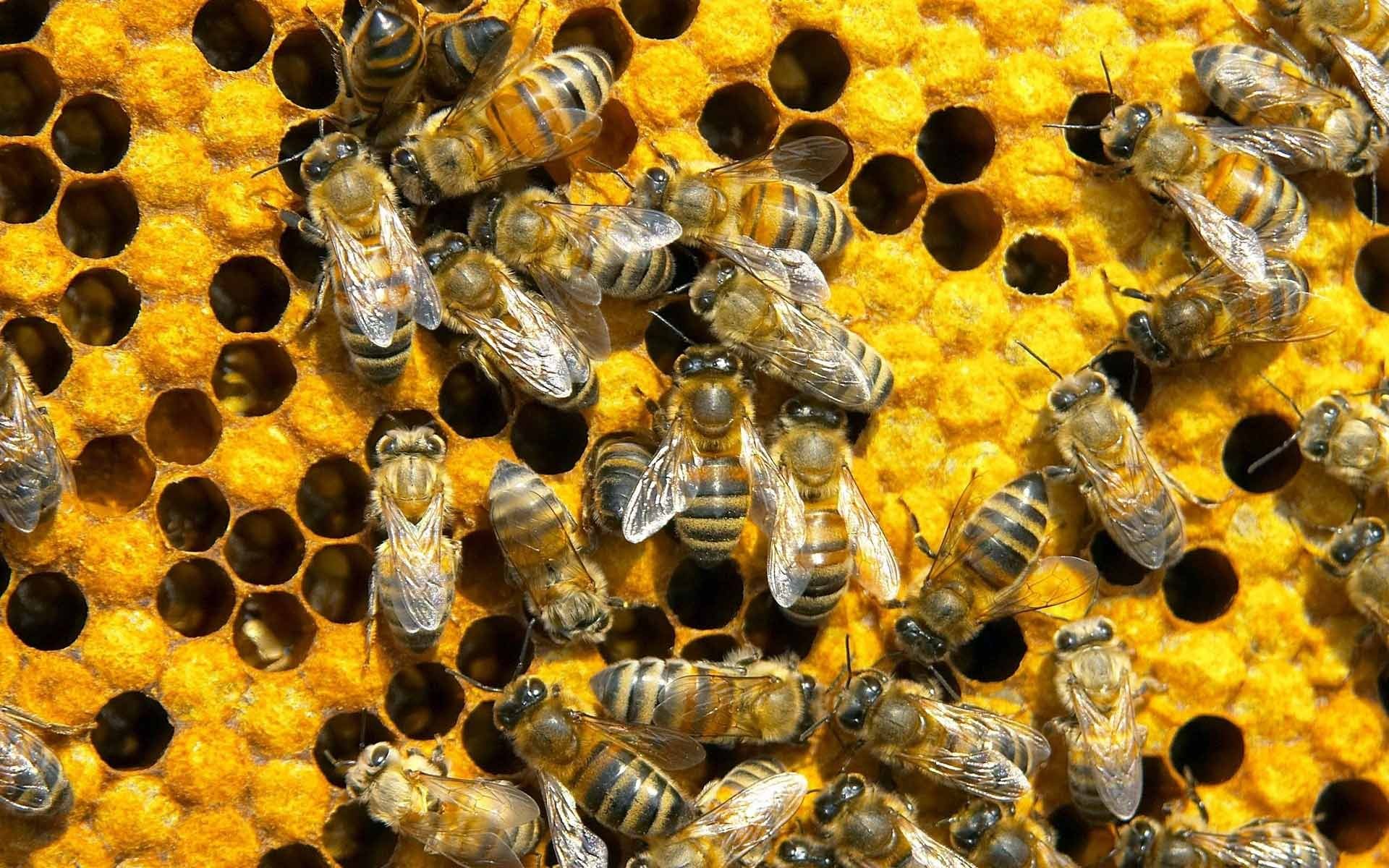
About Bees
Apis mellifera
Honey bees have been kept for both their honey and wax for thousands of years. The earliest records of humans eating and collecting honey have been found in prehistoric 8,000 year-old cave paintings in Spain.

The practice of beekeeping is much younger than the total age of bees on our planet. A 100-million-year old bee fossil was found embedded in amber.
A colony of honey bees consists of up to 50,000 bees per hive. What looks at first glance like a complete mess is actually a well-organized superorganism. All members of the community, whether queen, drone, or worker, are aiming for the same goal: ensuring the survival of the colony and its offspring.
To achieve this goal, each type of bee performs a designated role in the hive:
The Queen
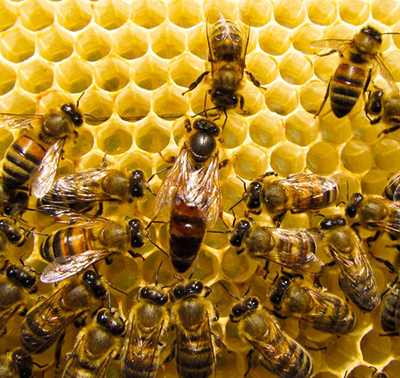
- Only 1 queen bee per colony
- Lives about 5-6 years
- The queen bee is the only reproductive individual in the colony - laying over 2,000 eggs per day
- Controls what takes place in the hive by means of pheromones
- Supports the learning behavior of the worker bees
- Keeps the beehive together
- Suppresses the development of ovaries and rearing of new queens that could replace her
- Attracts the drones during mating season
- Can survive after stinging. Mostly uses her stinger to kill other queens
Like the workers, the queens initially emerge from fertilized egg cells. However, queens differ in that they are fed more of the nutritious royal jelly in their own queen cells. Because of this special food, the queen grows bigger in size than the other bees.
Multiple queens are produced at once, however the first to hatch wins, so to speak. When the first queen hatches after about 16 days, she uses her sting to kill her queen rivals. There can only be one queen in each hive.
After the queen kills off her rivals, she goes on her mating flight to mate with over 80 drones before returning to the hive. She performs this massive mating session only once in her life, returning home with up to 10-million sperms in her spermathea.
The Workers
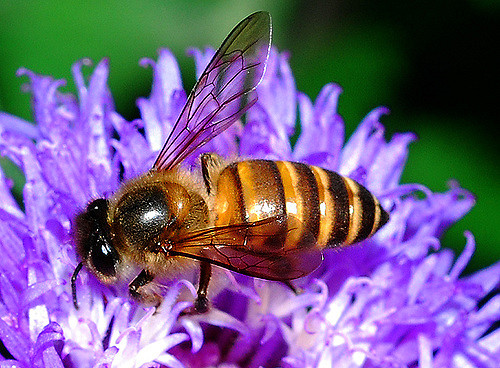
- 20,000 to 80,000 female worker bees in a colony
- Live about 4 to 6 weeks
- All worker bees are sterile females
- Each worker bee will perform a variety of duties throughout her short life
- As they age, their duties will become riskier and require further venturing from home
- Do all the work:
- Forage
- Feed the young
- Produce honey
- Build and repair the honeycomb
- Cap the comb cells
- Produce wax
- Keep the hive clean
- Defend the hive against intruders
- Bees have 2 stomachs - one for eating and one for storing nectar to carry back to the hive
- Have a stinger, but if a worker bee uses her stinger, she will die
- A honeybee can fly 24km in an hour at a speed of 15mph. Its wings beat 200 times per second or 12,000 beats pr minute
- Bees carry pollen on their hind legs called a pollen basket. Pollen is a source of protein for the hive and is needed to feed to the baby bees to help them grow
- The average worker bee makes about 1/12th of a teaspoon of honey in her lifetime
- A single beehive can make more than 100 pounds (45 kg) of extra honey. The beekeeper only harvests the extra honey made by the bees
The worker bees are only initially fed royal jelly when they are still part of the larva brood. Later, they eat honey, nectar, or pollen and drink a little water.
Young bees (about 1-3 weeks old) usually stay in the hive and help the hive by cleaning cells, taking nectar and pollen from forager bees, feed the young and old, build honeycomb out of wax, regulate temperature and humidity within the hive, and guard the entrance to the hive.
During the second half of her life, she will become a forager bee, searching the surroundings for nectar, pollen and water, providing those remaining at home with all of life's necessities.
The Drones
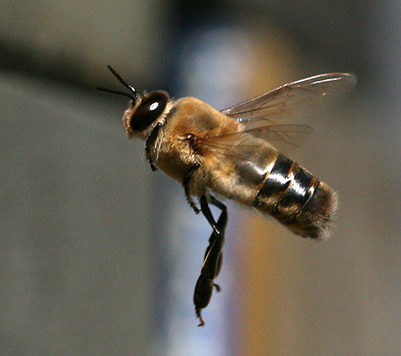
- All drones are male bees
- About 100-200 drones in a colony
- The men are significantly in the minority within the female population
- The sole purpose of a drone is to fertilize a queen bee
- Drones compete with thousands of other drones in drone congregation areas to mate with virgin queens from other colonies
- If a drone succeeds with his mission, he uses his entire sperm supply and dies
- Drones that do not succeed, are banished from the hive, becoming socially isolated
Bees are important indicators for the health of the environment. When something is wrong with our bees, something is wrong with the environment!
Read more on our next page about what you can do to help bees.
Beehive and Honeycomb Construction
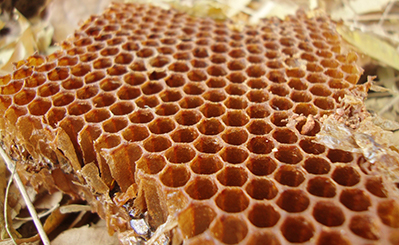
Beehives are the home of a honey bee colony. They are rarely found in the wild, but that is because of the growing number of beekeepers that are helping bees and taking care of them. Beekeepers provide the bee colonies with housing and monitor for overpopulation, pests and diseases.
The worker bees then construct the honeycomb themselves in the wooden frames provided by the beekeeper. They build using beeswax produced in their bodies by exuding small wax scales, molding them with their mouth and then mixing them with their own glandular secretion.
It takes over 125,000 wax scales to make 100 grams of beeswax. This amount can be used to construct about 8,000 cells for the storage of pollen, honey and their young.
The bees' honeycomb pattern is both a geometric and architechtural marvel that boggles the minds of many mathematicians. On top of this, bees build their comb using the most economical and efficient shape from an energy perspective - the hexagon.
As completed hexagons, the cells have a uniform wall thickness of just 0.07 millimeters and are always between 8 and 10 millimeters apart.
Sources:
European Honey Bee - Apis mellifera

